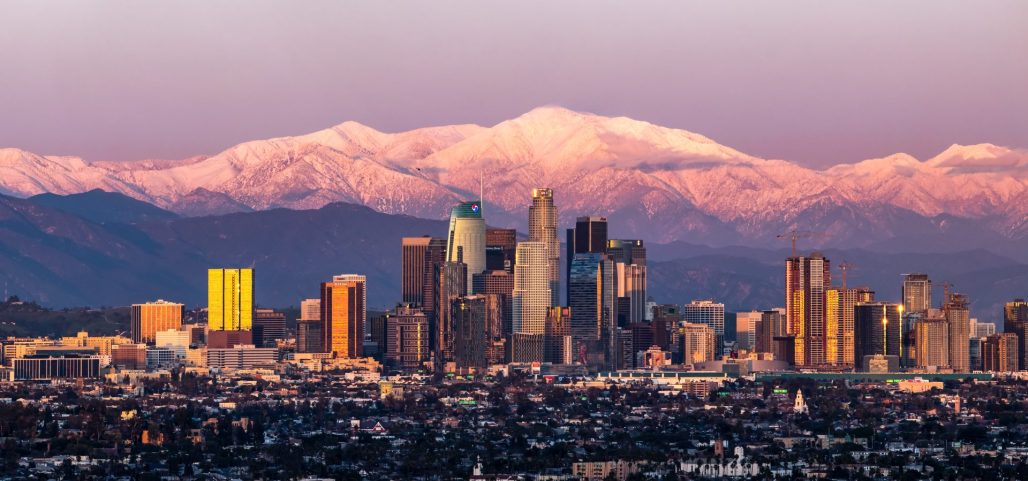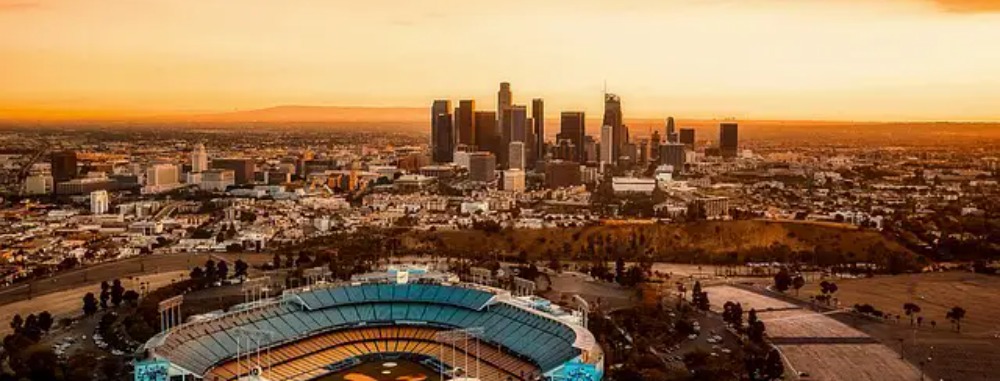Landmarks in Los Angeles
Los Angeles is a truly timeless city and one of the most iconic and historic cities in the United States. From its vibrant streets to its picturesque skylines, the City of Angels has something to offer everyone. For the adventurous explorer, LA offers a wealth of iconic landmarks and historic sites that are sure to delight. Here are 10 of the most noteworthy landmarks that you can find in LA:

The Hollywood Sign
The Hollywood Sign is one of the most remarkable and recognizable landmarks in all of Los Angeles. A testament to the entertainment industry, this emblem was initially constructed in 1923 for an advertisement promoting a housing development known as Hollywoodland. Each letter of the iconic 13-letter phrase is constructed from metal squares and stands 30 feet wide and 43 feet tall, illuminated by bright lights at night.

Unfortunately, the intended development eventually failed due to the Great Depression. However, the sign still remained, with the city eventually removing the ‘land’ from its title to create the now distinct Hollywood phrase. With a history reaching over 90 years, the Hollywood Sign remains an enduring symbol of Hollywood’s timeless magnetism and revolutionary creativity. It has come to signify that even in difficult times, stars can be born and fortune can last in the magical city of dreams.
Union Station
Union Station, the largest railroad passenger terminal in the Western United States, is a testament to the grandeur of American architecture. Constructed in 1926 by The Parkinsons, the building combines Dutch Colonial, Mission Revival, and Streamline Moderne styles to create an open and airy space that belies its relatively small size when compared with other Union Stations.
In addition to serving as a major hub for travel, Union Station has also become a popular wedding and reception site in recent years, having appeared in several films such as “The Italian Job”, “Pearl Harbor”, and “Charlie’s Angels: Full Throttle”. Visitors to Union Station will surely be impressed by its awe-inspiring beauty and timeless elegance.
The Santa Monica Pier
The Santa Monica Pier has been a beloved landmark for over a century, first built in 1909 to accommodate a pipeline into the ocean. Over the years, it has transformed from an industrial utility hub to a vibrant tourist destination. Visitors flock to the pier to experience thrills on the solar-powered Ferris Wheel at Pacific Amusement Park and take a spin on the carousel built in 1920.
A wide array of restaurants, including Bubba Gump Shrimp – owned by some of the producers of the Academy Award Winning Movie “Forrest Gump” – line the pier for those looking to treat themselves to a snack or meal. In addition to being an immensely popular spot for locals and tourists alike, the pier has also seen its fair share of celebrity attention, being featured in various TV shows and movies such as “Charlie’s Angels”, “Keeping Up with the Kardashians”, “The Mod Squad”, “The Mindy Project”, “Grey’s Anatomy”, and “Modern Family”. A visit to this iconic location could even deliver a chance encounter with a film crew!
The Hollywood Bowl
The Hollywood Bowl is an iconic venue that has seen some of the most memorable performances from US and international acts since its inception in 1922. Initially known as Daisy Dell, the theatre was purchased by the Theatre Arts Alliance for a mere $47,500 ($670,898.63 in today’s money), who sought the site for outdoor shows during the summer season. When it formally opened, the stage boasted a basic canopy with crude wooden benches for seating, a far cry from what modern concertgoers experience today. The LA Philharmonic was the first act to play at the venue and tickets cost only 25 cents at the time.
Still the largest natural amphitheater in the US, The Hollywood Bowl has attained recognition not just for its musical guest appearances, but also for cinematic purposes. It has been featured as a backdrop in films such as “Beaches”, “Some Kind of Wonderful” and “A Star is Born”. The Hollywood Bowl continues to be an integral part of LA culture and boasts some of the most iconic events in music history.
Griffith Observatory
The Griffith Observatory is one of the most iconic landmarks in Los Angeles, attracting over one million visitors each year. Established in 1935 by philanthropist Griffith J. Griffiths, it was initially dedicated as a public resource for science and astronomy. Entrance to the observatory is free, and it hosts various monthly events, including viewing parties, public talks, and special events.
The Samuel Oschin Planetarium is also located within the observatory, offering guests a nominal fee to view the stars and planets from its dome-shaped theater. Furthermore, movie fans will recognize the Observatory from its many appearances in films such as “Rebel Without a Cause” starring James Dean and “Full Throttle” with Charlie’s Angels. It has also famously been used as the setting of the welcome center in “Jurassic Park”, a meteors crash site in “Transformers”, and much more. Finally, stunning views of Los Angeles await any visitor at the peak of the observatory.
Olvera Street
Olvera Street is a historic district located in downtown Los Angeles. Established in 1930, the street was named in honor of Antonio F. Olvera, who served as the first mayor of Los Angeles from 1835 to 1836. The street consists of a collection of Mexican-style adobe structures, some dating as far back as the 1820s. Visitors to Olvera Street will find colorful shops and restaurants offering authentic Mexican cuisine, traditional handicrafts, and live entertainment.
A popular landmark on the street is Avila Adobe, the oldest house in Los Angeles, built in 1818 by Fransisco Avila and his wife Maria Ygnacia Lopez de Carrillo. Other attractions include Sepulveda House, Los Angeles’ first two-story brick building; La Plaza, which serves as an outdoor learning center and community space; and Nuestra Senora Reina de Los Angeles Church, the city’s oldest standing church. Olvera Street is a vibrant hub of cultural and historical significance that offers an invaluable glimpse into the past and present of downtown Los Angeles.
Angels Flight Railway
Angels Flight Railway is a Los Angeles landmark that has been in continuous operation since 1901. Located downtown, this inclined railway is the world’s shortest funicular and connects the historic Bunker Hill neighborhood to Downtown Los Angeles. As one of the oldest attractions in the city, Angel’s Flight was closed for 33 years due to safety concerns before eventually reopening in 2018.
The historic tramway is made up of two funicular cars, Sinai and Olivet, and runs on an inclined plane between its two stations. The lower platform, located at Hill Street and 3rd Street, is known as the “Lower Station” while the upper platform at California Plaza is called the “Upper Station”. The unique tramway runs for a distance of 315 feet, makes a 33-degree angle along the slopes of Bunker Hill, and covers 110 vertical feet.
The railway line has played a significant role in the history of Los Angeles. It has appeared in several films and novels over the years, thus solidifying its status as an iconic part of the cityscape. Today, Angel’s Flight continues to operate 365 days a year, offering passengers a unique way of getting around the downtown area and experiencing a piece of LA’s past.
Avila Adobe
The Avila Adobe is one of the most iconic landmarks in Los Angeles. Located in the heart of the city, it is the oldest existing structure in all of the city of Los Angeles. Built in 1818 by Francisco Avila, the adobe was originally part of his large ranch. He used the property to house his family, raise horses and cattle, and farm crops.
Today the Avila Adobe is open for public tours as a historic landmark and museum. Visitors can explore its rooms and courtyards, enjoy interactive exhibits, and learn about its original owners’ stories. The building’s history is also preserved through preservation efforts such as restoring its original roof and replanting native gardens.
With its age, cultural significance, and proximity to downtown LA’s attractions, the Avila Adobe makes for both an educational and enjoyable outing. The site offers something for everyone: tourists can learn the history behind this important site, while locals can appreciate the roots that lie beneath their bustling city.
Mission San Gabriel Arcángel
Mission San Gabriel Arcángel is a historic Spanish mission located in Los Angeles, California. Built in 1771, it is the fourth of twenty-one missions that were part of a network established by Spanish missionaries in Alta California during the late 18th century. This landmark has many features that make it significant to Los Angeles’ history. One prominent feature is its iconic bell wall, which consists of four brick towers, all adorned with bronze bells. The mission also boasts some of the oldest surviving structures in what is now Los Angeles, including the original adobe chapel and monks’ quarters.
Other remarkable features of the mission include its beautiful rose garden and the Mission’s cemetery, which contains over 3,000 graves dating back to its founding. In addition to its historical significance, Mission San Gabriel Arcángel is still actively used by members of the Catholic faith in the local community for Tuesday mass and other ceremonies. It remains an important cultural cornerstone for both locals and visitors, and it continues to be a popular tourist destination for those interested in learning more about the history of Los Angeles.
Queen Mary
Queen Mary is one of the most iconic and beloved landmarks in Los Angeles. Located on the Long Beach waterfront, the luxurious ocean liner has been a staple of the city since it docked here in 1967. Built in 1934 by the Cunard Line for trans-Atlantic crossings, Queen Mary made around 1,000 trips during her heyday, carrying two million passengers across the ocean.
Today, the grand vessel serves as an immaculate floating museum, providing visitors with a unique glimpse into the past. The ship contains several fascinating exhibits detailing its rich history, as well as restaurants, shops, and other attractions. A stroll through the decks provides a sense of nostalgia, transporting visitors to another era. From its art deco promenades to its elegant lounges and ballrooms, Queen Mary is an unforgettable and majestic reminder of Los Angeles’ maritime heritage.
La Brea Tar Pits
La Brea Tar Pits is an incredible reminder of the past, and a surprisingly vital part of the present. Not only does it offer insight into prehistoric life, but it can also serve as a powerful symbol for modern conservation initiatives. Its vast collection of fossils, its ongoing excavation and preservation projects, and its attempt to bridge the gap between the past and present make La Brea Tar Pits one of Los Angeles’ most iconic landmarks.
By paying homage to the Earth’s history, it speaks to the importance of cherishing our environment even today. With its impressive historical significance and continued relevance in the modern world, it is no wonder why so many people consider La Brea Tar Pits a must-see destination when visiting LA.
Final Word
Los Angeles is a city of incredible landmarks, from the iconic Hollywood Sign to the towering Griffith Observatory. These monuments form the backbone of LA’s diverse culture and are signifiers of its unique history. Whether it’s for their natural beauty or cultural significance, visitors to the City of Angels would be remiss if they didn’t take some time to explore these remarkable sites. By taking a leisurely stroll through urban parks or hiking up to the Hollywood Sign, residents and tourists alike experience the grandiose beauty of Los Angeles. The timelessness of these locations reinforces the idea that LA is a place where dreams come true and memories last forever.
